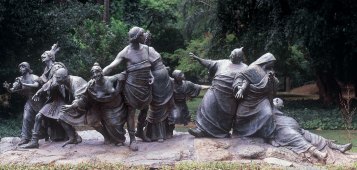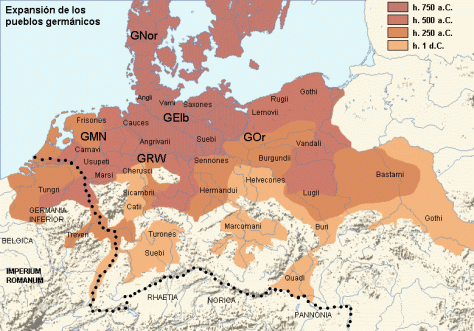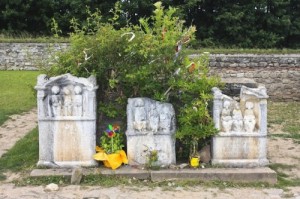| Castellano | Català |
|---|
If we fragment our culture (Judeo-Christian based) a little and we analyse some of its pieces some quite interesting facts arise that show the amalgam of influences from ancient civilizations that make up our cultural heritage. More or less we all have an idea of the traces that different pre-Christian ethnic groups left us: Saint John or festival of the summer solstice, Epiphany or the party of the light (ancient Greece), Assumption or feast in honour of Hecate – Artemis – Diana (goddess of the moon and queen of heaven also in Greek mythology) [1] and of course, also the winter solstice festival or Christmas holiday.
The “modern” religions did not emerge spontaneously and it took a considerable amount of time until they spread through all social strata. Without intending to simplify this process, it is undeniable that one of the consequences of this expansion was the assimilation of festivals and worship of previous civilizations. Among these festivals, Christmas plays a very important role because is a large mixture of many different traditions such as the celebration of Saturn’s birth (Roman festival of Saturnalia, Figure 1), the rebirth of the sun (northern tribes) and after the suggestion of Pope Julian I (350 AD!!) also the birth of Jesus of Nazareth. [2]

December 24, following the same Christian logic, can be interpreted as the night of Mary, as it is when she gives birth to the son of God. While it is true that in any homily eve she occupies a special position, it is also true that she has always been relegated to second place on the scale of importance. And this is somehow “surprising” since precisely in Germanic mythology this night was known as the Mother’s Night.
Depending on the geography we can find variations of the story as the Germanic peoples were many and spread throughout much of Europe (Figure 2) while mingling with native civilizations. Besides myths and traditions were transmitted orally so they were not documented until many centuries later.

Mōdraniht, Mütternacht or the Night of Mothers is a festival held during the winter solstice within the framework of the celebrations of July (Jól). [3] In this night the old founding mothers of the clan or tribe are revered, together with ancient mothers of many previous generations, the mother goddess Frigg and other deities of Roman influence known by the name of Matres or Matronae. Those women, also named Disen, were in charge of protecting the countryside and the clan and keep the wellfare and fertility growing. They were also the guardians of the field and the ones who helped women to give birth and protected men in war and in the hard work.

Among the Anglo-Saxon peoples of Germanic origin, the celebration consisted on offering a sacrifice to the Disen followed by a feast. Several altars were erected in honour of these Matres between the first and fifth century AD (Figure 3) although there are indications that the feast was already celebrated in the Bronze Age. [4] In the Norwegian tradition, the holiday celebrates the birth of the Sun, son of the winter goddess Frigg. In a purely astronomical context, the fact that the Sun is “born” on the winter solstice is a way of indicating that on this day, the position of the sun in the sky takes its lowest point, from it which can only grow .
It’s interesting how centuries of astronomical observations and analysis that allowed many civilizations understand the astral movements and that somehow connected people with nature, were progressively replaced by totally alien concepts. Probably a remnant of this knowledge always existed throughout the centuries despite the adoption of new religious rituals but I wonder how many people today know what is the winter solstice and what represents from an astronomical point of view.
Some people say it is no longer important or necessary to know what season we live in or why the Sun is at one point of the sky and not in an other, because in our daily life we have all the basics covered and do not need to worry about whether the harvest will be good or bad next winter. In addition, we may also think it is no longer important to celebrate the birth of God because as Marx said “religion is the opium of the people” or simply because it is no longer fashionable to be religious.
Celebrating Christmas has become big family meals and high stress levels to fulfil all gift expectations. Festivals and holidays are part of our culture and this is why we should all know exactly what we celebrate and why we celebrate it. Do we celebrate the birth of Jesus? Fantastic, what does that mean? Do we celebrate the Cagatió? Perfect, what is it?
What if this year we celebrate a Christmas eve in an ancient Germanic stile by honouring our mothers, grandmothers, sisters, wives, girlfriends and other important women in our lives? Now we already know the origin of the tradition 🙂
Rosa Mª Torrademé
Cover image: “The Dises” (1909) de Dorothy Hardy
Bibliography:
[1] http://www.monografias.com/trabajos6/paga/paga.shtml
[2] https://es.wikipedia.org/wiki/25_de_diciembre
[3] https://en.wikipedia.org/wiki/Yule
[4] Steinbock, Fritz “Das Heilige Fest: Rituale des traditionellen germanischen Heidentums in heutiger Zeit” Edition Roter Drache
[5] http://blog.wurzelwerk.at/?cat=11&paged=2
[6] http://www.wikiwand.com/es/Invasiones_b%C3%A1rbaras
Other articles from Rosa:



Un pensament sobre “Mōdraniht or Mother’s night”